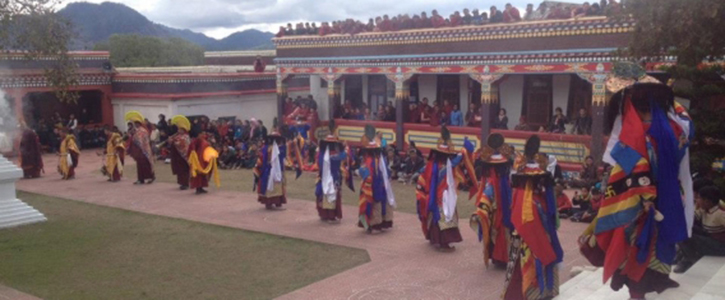
Objectives: The MCEC has four objectives:
- Beginning with solidifying the agricultural system with an irrigation system;
- Providing a cultural center for the community;
- Establishing an education system for the children that is supportive of their cultural and spiritual traditions;
- And finally creating the Bon religious and ritual support for Mustang Valley.
Objective 1: Solidifying the agricultural system with an irrigation system
The first priority of the MCEC was to stabilize local farming by developing a reliable irrigation system by 2015, so that local farmers of Pangling would enjoy stable irrigation of local crops year after year. The hope was that such an irrigation system would encourage local farmers to work their land to the fullest, increasing the likelihood that they keep and develop their land. This would have a stabilizing effect on the local population and minimize the break-down of local culture. Engineering and geological consultants were brought to the area in 2014 to develop a plan for the most stable irrigation system suitable for the region.
That plan was implemented over the following year and completed in 2015, resulting in stabilization of water resources despite highly variable rain and flows of the Kali Gandaki river that flows through Mustang Valley.
Objective 2: Providing a cultural center for the community
In June of 2014, the MCEC completed construction of a Cultural Center in the heart of Pangling, Nepal, on land donated by the community. Inauguration ceremonies were held in August with community leaders, Geshe Sobnam and donors.
The Cultural Center will be a platform to preserve, share and pass on traditional farming methods; to sustain weaving, shoe-making and other art of clothes-making; to continue traditional painting and wood carving practices; to practice indigenous folk medicine; and to learn indigenous music, singing and folk dancing to celebrate local festivals, e.g. harvest and the new year. This Cultural Center would also serve as a local gathering place for contact between younger and older villagers in such a way that a wide range of cultural practices would be sustained and passed on from generation to generation.
Objective 3: Establishing an education system for the children that is supportive of their cultural and spiritual traditions
While conditions have improved significantly in the last 15 years, and children are now taught Nepali and sometimes English in State-sponsored schools, the children receive no education of their own Indo-Tibetan language and traditions. The Indo-Tibetan culture has eighty to one hundred thousand volumes of their sacred spiritual tradition, but because the children are no longer learning Tibetan as a language, they no longer have access to their own spiritual tradition.
Since there is a lack of quality education in the villages, the children from the villages, need to move down to Jomsom to attend boarding school for a quality education. Providing a quality education at the Jomsom boarding school ensures that the children will learn to read and write as well as learning their native language and history, an opportunity that they might not have otherwise. Sending them to a boarding school some distance from Pangling decreases the likelihood that their families would keep them out of school to work the farms. At the same time, because the school is only a 4 hour walk from their home village, the children will not lose touch with their families, which has been a problem when children are sent as far away as Kathmandu or Northern India. In addition, the children will have an opportunity to learn Tibetan language, history and culture after school curriculum. The goal is to produce educated younger generation who can become carriers of indigenous culture.
The children go to the Nepalese state school nearby during the day, learning to read and write Nepali and English as well as science, math and history. When they return home to Geshe Asonam’s MCEC in the evenings and on weekends, the children additionally learn to read, write and speak Tibetan as well as learning Tibetan culture and history as part of larger multicultural education. The education provided by MCEC augments the education they are already provided by Nepali government.
Most of the children are unable to afford tuition, room and board costs. The cost for the scholarship for one child per year is approximately $900. This cost includes tuition, room and board, books, supplies, uniforms and examination fees.
Objective 4: Creating the Bon Religious and ritual support for the Mustang Valley
MCEC’s next step on this journey is to build a monastery/spiritual campus. Bon, the indigenous and oldest religion of Tibet, has strong roots in Mustang. The religious practices of Bon centered on local monasteries and have traditionally been the heart of cultural and religious life for the indigenous populations in this region. However, currently no Bon monastery exists in the area to support these practices for the local population.
The vision for this project comes directly from His Holiness Menri Trizin, the lineage holder for the Bon Tibetan spiritual tradition. Geshe Sonam, through MCEC, will oversee the project’s construction and ongoing management. The project will be constructed on land donated by the community and will include a Bon temple, living space for monks to support the ritual and spiritual life of Mustang Valley, the children's dormitory space, and a guest house for Western students.
- Mustang Culture and Education Centre
- Successful completion of the Cultural Center in Pangling
- Successful Completion of the Irrigation system to stabilize farming practice
- Successful Completion of the Children's Education System Supportive of Cultural and Spiritual Traditions.
- Mustang Valley Bon Monastery and Spiritual Campus





